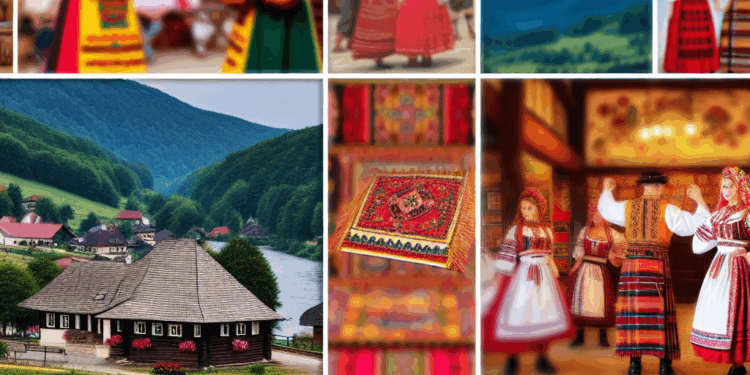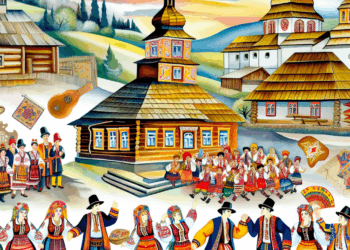Bukovyna is a unique region that lies on the border of Ukraine and Romania and has a rich cultural mosaic. The complex historical fate of the region has had a significant impact on its cultural heritage, where Ukrainian, Romanian, Jewish and Polish traditions are intertwined. In this article we will delve into the culture of Bukovina, looking at its traditions, folk costumes, crafts, festivals, music and folklore, while paying attention to the multinational context.
Historical context of Bukovina
Historically known as the land of multinational friendship, Bukovina has come under the influence of different states and cultures in different eras. In the 10th century, these lands became part of Kievan Rus, then they became part of the principality of Galicia-Volhynia. From the 14th century Bukovina was under the rule of the Principality of Moldavia and later under the rule of Austria-Hungary. These historical movements created a unique cultural puzzle where each ethnic community left its mark.
Folk traditions
The traditions of Bukovina cover many aspects, from rites and rituals to customs in everyday life. One of the most important traditions is the celebration of winter Holy Days and Pancake Day. At this time, villages hold folk festivals, carnivals and special rituals related to harvest and fertility. Preserving ancient rituals is not only a tribute to ancestors, but also a way to strengthen local identity.
Holidays
Some of the most famous holidays in Bukovina include:
-
- Village Day: Most villages organise festivals where residents gather, celebrate Christian rituals and hold folk festivals. It is a time when the older generation shares history and traditions with the younger generation.
-
- Kupal celebrations: These are associated with the summer solstice, where songs, dances and wreath making create an atmosphere of unity with nature.
-
- Folk artfestivals: For example, the Bukovyna Mosaic Festival brings together artisans from across the region to showcase achievements in folk arts and crafts.
Folk costumes
Folk costume has incorporated a variety of elements from different ethnic groups. The main features of Bukovinians’ costumes depend on the season and region.
Ukrainian costumes
Women’s Ukrainian costumes are usually made of linen, and sundresses and blouses are decorated with embroidery. For example, the embroidery on jackets is often a symbolic representation of life and nature. On the feet are cherevichki, and women wear traditional wreaths of flowers on their heads.
Romanian costumes
Romanian folk costumes are characterised by bright colours, lace and fringe. Men usually wear white shirts with black belts and wide trousers, while women wear long skirts and shawls, which are often tied around the head.
Jewish and Polish elements
Jewish cultural tradition has also left a noticeable mark on costumes: elements of traditional Jewish art, such as patterns and embroidery, can be found here. Polish costumes, particularly in the villages, also retain features of folk style with characteristic colours and shapes.
Crafts
Bukovina is famous for its folk crafts. Household crafts such as weaving, pottery, woodcarving and embroidery have long been developed here. Some of the main types of crafts include:
-
- Pottery: Potters from Bukovina use traditional methods to create crockery and decorative objects. For example, unique pottery with characteristic patterns can be found in the city of Chernivtsi.
-
- Wood carving: This technique is ideally suited to the local natural resources. Masters create both practical and decorative objects.
-
- Embroidery: Embroidery on clothing and tablecloths is often decorated with traditional designs that have been passed down through generations.
Craftsmen such as Grigory Izosimchuk and his family are known for their pottery and produce unique items in their workshop.
Music and folklore
The music of Bukovina is a reflection of the multinational composition of the region. Both folk and modern folk performers can be found here, utilising traditional instruments such as the bandura, violin, dulcimer and flute.
Folklore traditions
The folklore of Bukovina is rich and multifaceted. It is reflected in songs, fairy tales, anecdotes and oral tradition. For example, the famous Christmas carols and songs telling about the life and customs of the inhabitants are usually passed on orally.
Folklore ensembles such as “Promin” and “Kalina” from Chernivtsi actively participate in events and contribute to the preservation and popularisation of folk music.
Instruments and performance
Both folk instruments and more modern instruments are used in the performance of music. Traditional songs are often accompanied by folk instruments such as:
-
- Trembita: A long wind instrument popular in the Carpathian regions.
-
- Cymbals: Sounded mainly at festivals and folk festivals.
Multiculturalism of the region
Another important aspect of Bukovina’s culture is its multiculturalism. Borders have shifted and communities have mixed, but each of the ethnic groups has brought its own traditions and customs.
Ukrainian culture
Ukrainian culture is mainly represented by folklore, traditional music and rituals. Communities maintain their identity through language and cultural characteristics.
Romanian culture
Romanian traditions, such as unique rituals, festivals and gastronomy, influence the daily life of small towns and villages.
Jewish culture
The Jewish community has also played an important role in the cultural life of the region. Their traditions tend to focus on religious festivals and certain crafts such as cooking and art.
Polish culture
Polish culture is felt through the folk costumes, music and festivals that were common among the Poles living in Bukovina.
Conclusion
The culture of Bukovina is a unique combination of historical influences and traditions, where Ukrainian, Romanian, Jewish and Polish elements meet. The diversity of customs and crafts accumulated from generation to generation helps to preserve the identity of the region and reminds of its rich heritage. The culture of Bukovina not only enriches the Bukovinians themselves, but also attracts the attention of tourists and researchers who want to understand this fascinating area where different cultures and traditions intersect.
Thus, Bukovyna remains a vivid example of how multinational communities can co-exist and complement each other, creating examples of cultural diversity, which is important to preserve and develop for future generations.








